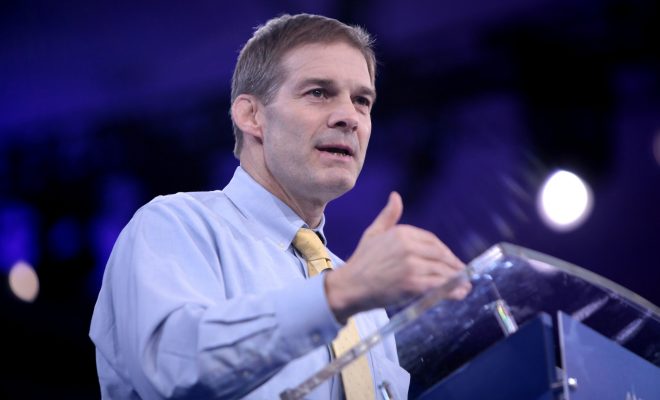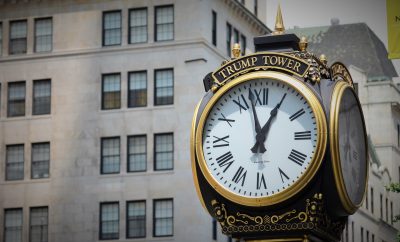 "Jim Jordan" courtesy of Gage Skidmore; License: (CC BY-SA 2.0)
"Jim Jordan" courtesy of Gage Skidmore; License: (CC BY-SA 2.0)
Politics
What is the House Freedom Caucus?
Last month, House Republican leaders introduced their new health care plan, the American Health Care Act. The effort was ultimately unsuccessful, and on March 24 the bill was withdrawn, largely because of Republican infighting. Republican moderates worried that the bill was too extreme, and would be harmful for their constituents. But Republicans further to the right disagreed, arguing that the bill actually didn’t go far enough. Those right-wing Republicans were led by the House Freedom Caucus, a caucus that has only been in existence for two years, but in the Trump era, has made quite a name for itself. Read on to learn more about the inception of the House Freedom Caucus, its ideology, and its members.
History of the House Freedom Caucus
The formation of the House Freedom Caucus was announced in January 2015. Its founding members were all hardline Republican representatives: Scott Garrett of New Jersey, Jim Jordan of Ohio, John Fleming of Louisiana, Matt Salmon of Arizona, Justin Amash of Michigan, Raúl Labrador of Idaho, Mick Mulvaney of South Carolina, Ron DeSantis of Florida, and Mark Meadows of North Carolina. The nine founders reportedly planned their new caucus at a retreat in Hershey, Pennsylvania, a few weeks before they announced its formation.
According to a statement that offices of the members released:
The House Freedom Caucus gives a voice to countless Americans who feel that Washington does not represent them. We support open, accountable, and limited government, the Constitution and the rule of law, and policies that promote the liberty, safety, and prosperity of all Americans.
The House Freedom Caucus is notably more conservative than the rest of the House, and Americans in general. According to Tim Dickinson of Rolling Stone:
The Freedom Caucus acts like a third party in Washington because the political fates of its members are not yoked to the national GOP. Their districts rate R+13, according to Cook Political Report data crunched by Rolling Stone. This means their districts vote 13 percent more Republican than the nation as a whole — and are nearly a third more partisan than the median GOP seat (R+10).
The Split from the Republican Study Committee
The House Freedom Caucus was an offshoot of the Republican Study Committee (RSC), a much larger, but traditionally very conservative, caucus. However, in 2015, the year the House Freedom Caucus was founded, some conservative Republicans thought the RSC had become too centrist. The RSC had also become quite clunky and large–it currently has over 170 members.
Reports on whether the House Freedom Caucus’s split from the RSC was amicable have differed. The founding members tactfully told the press that they believed a smaller, more mobile organization was needed to pull the party to the right. Some members of the House Freedom Caucus remained as RSC members, while others left the larger group.
The House Freedom Caucus and House Speaker John Boehner
Congressman John Boehner announced that he would step down from the position of Speaker of the House in September of 2015. He had held the post since 2011, when Republicans gained majority control of the House.
It was reported that Boehner stepped down, at least in part, due to pressure from the House Freedom Caucus. If all of the 30-odd members of the caucus had refused to support him, he would not have had enough votes to remain the House leader. The House Freedom Caucus members wanted Boehner to push harder on some far-right issues, like defunding Planned Parenthood.
Who are the Current Members of the House Freedom Caucus?
No one is completely sure. The invite-only group isn’t public with its roster. However, a number of media outlets have identified the members who have been open about their relationship to the caucus. Here are the congressmen who are believed to currently be part of the House Freedom Caucus:
- House Freedom Caucus Chair Mark Meadows, North Carolina
- Alex Mooney, West Virginia
- Andy Harris, Maryland
- Bill Posey, Florida
- Brian Babin, Texas
- Dave Brat, Iowa
- David Schweikert, Arizona
- Gary Palmer, Alabama
- Jeff Duncan, South Carolina
- Jim Bridenstine, Oklahoma
- Jim Jordan, Ohio
- Jody Hice, Georgia
- Joe Barton, Texas
- Justin Amash, Michigan
- Ken Buck, Colorado
- Mark Sanford, South Carolina
- Mo Brooks, Alabama
- Morgan Griffith, Virginia
- Paul Gosar, Arizona
- Rand Weber, Texas
- Raul Labrador, Idaho
- Rod Blum, Texas
- Ron DeSantis, Florida
- Scott DesJarlais, Tennessee
- Scott Perry, Pennsylvania
- Steve Pearce, New Mexico
- Ted Yoho, Florida
- Tom Garrett Jr., Virginia
- Trent Franks, Arizona
- Warren Davidson, Ohio
Who are the Former Members of the House Freedom Caucus?
There are also some former members associated with the caucus. These include congressmen who lost re-election bids in 2016, including founding member Scott Garrett of Florida and Tim Huelskamp of Kansas. Former Congressmen John Fleming of Louisiana and Marlin Stutzman of Indiana ran for other positions and were defeated.
Retired Congressmen Curt Clawson of Florida, Cynthia Lummis of Wyoming, and Matt Salmon of Arizona also used to be counted among the members. Lummis seems to be the only female member ever associated with the caucus, so as it currently stands, the caucus appears to be entirely male. One founding member, Mick Mulvaney, was appointed by President Donald Trump as the director of the Office of Management and Budget, and therefore is no longer in the House of Representatives.
There were some members who decided to remove themselves from House Freedom Caucus membership. Congressmen Tom McClintock of California and Reid Ribble of Wisconsin quit after the group’s role in forcing Boehner out of the Speaker of the House position. After he quit, McClintock said: “I feel that the HFC’s many missteps have made it counterproductive to its stated goals and I no longer wish to be associated with it.” And Ribble took his complaints a step farther, saying:
I was a member of the Freedom Caucus in the very beginning because we were focused on making the process reforms to get every Member’s voice heard and advance conservative policy. When the Speaker resigned and they pivoted to focusing on the leadership race, I withdrew.
Representative Keith Rothfus of Pennsylvania resigned from the caucus last winter, saying that although his ideology still matched the group’s, he wanted to focus on “substantive policy work rather than procedural mechanisms the group uses to exert influence.” Representative Barry Loudermilk, of Georgia, also quit quietly, saying that he just didn’t have the “bandwith” to be in the group.
Most recently, Representative Ted Poe, from Texas, quit the House Freedom Caucus after the group’s role in the health care bill failure at the end of March. Poe said in an interview on “Fox & Friends” that he felt as though the caucus was saying “no” too much:
The president, Speaker Ryan, came to the Freedom Caucus and made some changes that we wanted several times. But no matter what changes were made, the goal post kept getting moved and at the end of the day, ‘no’ was the answer. And sometimes you’re going to have to say yes.
Poe chose to resign, saying that, “at some time we’re going to have to say ‘yes.’ We are in power. We need to lead.”
The Freedom Caucus in the News
Since its inception, the two most news-worthy events involving the House Freedom Caucus were its founding, and its role in John Boehner’s resignation. But the Freedom Caucus was recently vaulted into the spotlight with the AHCA controversy.
The American Health Care Act
Regardless of whether the assessment is fair or not, the House Freedom Caucus has been largely blamed by the media, President Donald Trump, Speaker of the House Paul Ryan, and others, for the bill’s failure.
The big sticking point with the AHCA for many of the members was that it wasn’t conservative enough, and didn’t provide for a full repeal. At one point, it was reported that the Trump Administration was negotiating with the House Freedom Caucus to secure the needed votes to pass the bill in the House of Representatives. The Trump Administration offered to get rid of “essential health benefits” that were guaranteed under Obamacare. These essential health benefits included maternity care, emergency room visits, and mental health services. But, the Freedom Caucus still claimed that the bill didn’t go far enough, and on March 24, the bill was pulled.
Trump’s Attack
In the wake of the AHCA withdrawal, President Donald Trump started criticizing the House Freedom Caucus. On March 27, Trump tweeted: “The Republican House Freedom Caucus was able to snatch defeat from the jaws of victory.” He followed that up on March 30, by tweeting: “The Freedom Caucus will hurt the entire Republican agenda if they don’t get on the team, & fast. We must fight them, & Dems, in 2018!” The verified Twitter account for the House Freedom Caucus responded to Trump’s criticism on March 31, saying that the group wants to hold true to its promise to repeal the Affordable Care Act, and arguing that only 17 percent of Americans supported the AHCA.
Conclusion
The House Freedom Caucus is relatively new, having just been founded in 2015, and best known for being involved in Speaker of the House John Boehner’s resignation. But in the Trump era, with both the Executive and Legislative branches controlled by the Republican Party, the House Freedom Caucus has become an increasingly influential part of GOP House dynamics. What the group will do with that newfound power remains to be seen.








Comments